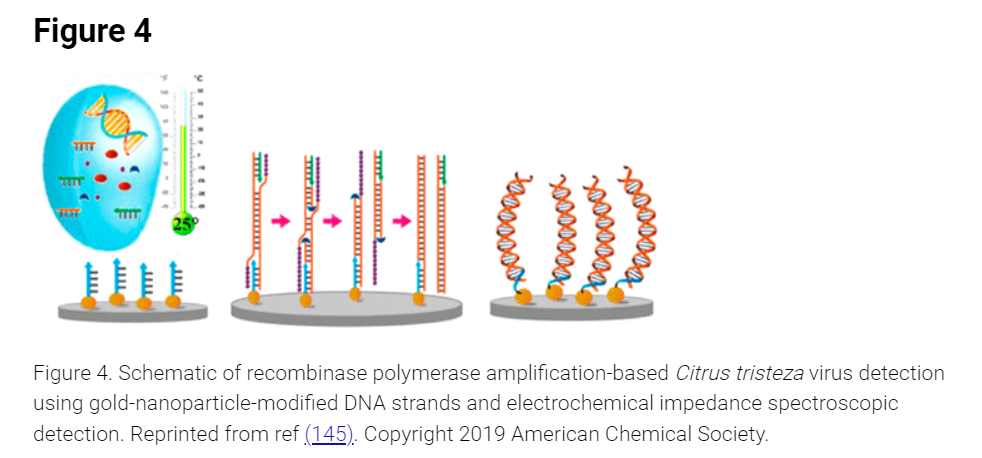Figure 4 FREE TUTT HHH ())) Figure 4. Schematic of recombinase polymerase amplification-based Citrus tristeza virus detection using gold-nanoparticle-modified DNA strands and electrochemical impedance spectroscopic detection. Reprinted from ref (145). Copyright 2019 American Chemical Society. VISI ***** TIIT *********
Genetic Recombination
Recombination is crucial to this process because it allows genes to be reassorted into diverse combinations. Genetic recombination is the process of combining genetic components from two different origins into a single unit. In prokaryotes, genetic recombination takes place by the unilateral transfer of deoxyribonucleic acid. It includes transduction, transformation, and conjugation. The genetic exchange occurring between homologous deoxyribonucleic acid sequences (DNA) from two different sources is termed general recombination. For this to happen, an identical sequence of the two recombining molecules is required. The process of genetic exchange which occurs in eukaryotes during sexual reproduction such as meiosis is an example of this type of genetic recombination.
Microbial Genetics
Genes are the functional units of heredity. They transfer characteristic information from parents to the offspring.
question: Can you summarize and explain for me what you want to tell in the article below? Can you explain the figure? When I read it myself, I do not understand exactly what is meant by the article. It would be nice if you could highlight the important points. You can use them in a figure or diagram to explain. thank you and hava a nice day :)
Article:
Nanotechnology Tools to Detect SARS-CoV-2
Standard procedures for detecting the virus from nasopharyngeal and/or oropharyngeal swabs have been reviewed recently and are primarily based on reverse transcription polymerase chain reaction (RT-PCR). Here, we would like to mention some preliminary ideas on nanotechnology-based assays to monitor the presence of SARS-CoV-2. A simplified test and variants thereof to detect viral proteins (e.g., HIV or influenza virus) without the need for expensive equipment is based on the color change of Au NPs bound to antibodies. Similar to the enzyme-linked immunosorbent assay (ELISA) antibodies coupled to Au NPs will form a tertiary complex with the viral antigen and a capture antibody, thereby leading to the immobilization and agglomeration of NPs, which shifts the color from red to blue. Such simple, low-cost procedures could be of value in regions with low-
Nanobiosensors are a valuable alternative to conventional laboratory equipments for clinical and environmental analyses. Usually, nanobiosensors combine the excellent electrical and optical properties of nanomaterials with biological or synthetic molecules used as receptors to detect selectively any kind of analyte. The detection of whole cells (e.g., cancer cells) using electrocatalytic properties of Au NPs toward hydrogen evolution has been reported. This cell-sensing device is based on the reaction of cell surface proteins with specific antibodies conjugated to Au NPs. The same detection technique can also be applied to the detection of viruses, taking advantages of the known antigens and available antibodies. Recently, as mentioned above, a FET sensor (modified with graphene sheets) that uses a specific antibody against SARS-CoV-2 spike protein was reported to detect SARS-CoV-2 in culture medium (limit of detection, LOD: 1.6 × 101 pfu/mL) and clinical samples (LOD: 2.42 × 102 copies/mL).
Nanobiosensors are a valuable alternative to conventional laboratory equipments for clinical and environmental analyses.
Researchers have also demonstrated solid-phase isothermal recombinase polymerase amplification (RPA) for the detection of Citrus tristeza virus (CTV) for plant disease diagnostics. Gold NPs linked with DNA strands on top of an electrode were used to detect in situ amplified CTV (RPA assay for amplification of the P20 gene, 387 bp) using
Paper/nanomaterial-based sensors, in general, and, particularly, NP-based lateral-flow devices that are observed with the naked eye or operated through a smartphone are now the most reported testing platforms for the analysis of COVID-19-related biomarkers. Nanopaper and nanochannels may also offer cost-efficient alternatives for detection of viruses and related biomarkers. Nanomaterials are already being used in theranostics applications. Although the field of nanomaterial applications in nanotheranostics is still in its infancy, a thoughtful review of the performance characteristics of known nanomaterials may open new avenues of investigation, even for COVID-19-related applications (for both diagnostic and therapies, including vaccines).

Step by step
Solved in 2 steps









